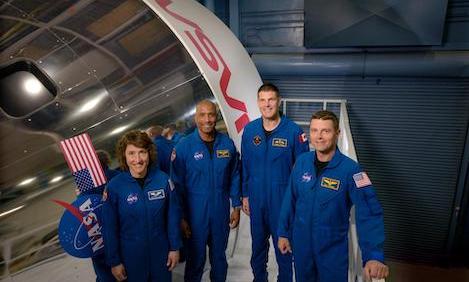


The Artemis II crew (left to right: Christina Hammock Koch, Victor Glover, Jeremy Hansen, Reid Wiseman) with the Orion spacecraft.
Humans are going back to the moon! NASA is planning to launch Artemis II, which will be the first crewed lunar, or moon, mission in more than 50 years. On April 3, 2023, NASA named the crew members who will take on this historic mission.
Among the 4-member crew is Christina Hammock Koch. She will become the first woman on a lunar mission. A very experienced astronaut, Koch holds the record for longest time in space by a woman—328 days.
Victor Glover is another experienced astronaut on the crew. He piloted his first spaceflight in 2020, spending more than 6 months on the International Space Station. He will be the first African American to take part in a lunar mission.
Artemis II will be the first spaceflight for astronaut Jeremy Hansen. He is a former fighter pilot in the Canadian Air Force. Hansen will become the first Canadian on a lunar mission.
The fourth and final crew member is Reid Wiseman. He will serve as the commander of the Artemis II mission. During Wiseman’s last mission in 2014, he spent 165 days aboard the International Space Station.
The Artemis II mission is schedule to launch in November 2024. The crew will lift-off from Cape Canaveral in Florida, circle the Moon, and splash-down in the Pacific Ocean. The distance from Earth to the moon is about 230,000 miles. The mission will take 10 days.
The exact flight path of the Artemis II mission is yet to be determined. However, NASA officials estimate that the crew will travel an additional 6,400 miles beyond the moon before turning back towards Earth. When their journey is complete, the crew of Artemis II will have traveled farther into space than any crewed spaceflight in history.
Artemis II will be just the second mission of the larger Artemis program. The crew will test the capabilities of the Orion spacecraft to maneuver and navigate in space. They will also test the spacecraft’s ability to sustain human life on the long journey to the moon and back. Even though Artemis II will not land humans on the moon, it will provide valuable data to the Artemis program.
The goals of NASA’s Artemis program are:
- to explore the moon’s surface.
- to establish a human presence on the moon.
- to build infrastructure to launch a mission to Mars.
To achieve these ambitious goals, NASA officials have emphasized the need for diversity in the Artemis program. NASA believes that the only way to achieve a mission to Mars is with the knowledge, talents, and support of all humans. In fact, NASA has vowed that Artemis III will land the first woman and person of color on the surface of the moon in 2025.


























